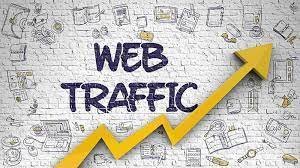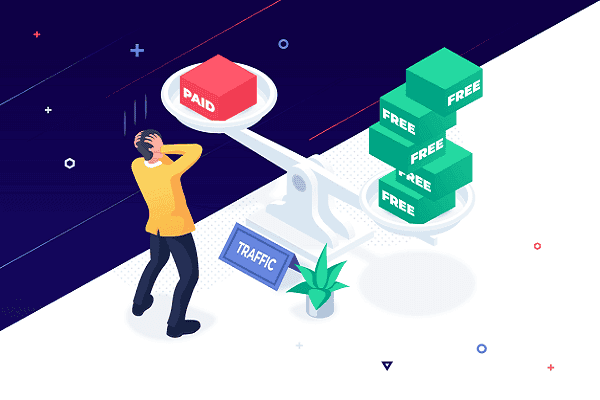Hi man! Imagine you’ve just gone live on your new website. Traffic is rolling in, almost like tumbleweed in a desert storm. Bloggers, marketers and business owners appear to worship at the altar of free traffic as a holy grail for online success. Can it really be this easy, this enticing, this rhetorically near-immaculate conveyor of so-called freegivers? You’d think not.
Yet what if you were told that, while those good numbers keep rising, behind the scenes there are actual real costs involved: your site’s functionality, its credibility, possibly even your own peace of mind? Exploring the weird underbelly of ‘free’ traffic might just be what’s necessary this year to shatter some of the mythos most often swallowed by the digital choir. Welcome to ‘The Cost of Free Traffic to Your Website’.
If you’re trying to get more traffic to your blog, business, or charity without spending a cent, you could be unwittingly generating a host of problems, from spam robot visitors faking up your analytics to low-quality organic visitors who will never convert for you. The cost of free is never truly as it seems. In this post, you’ll learn why, and you’ll discover some of the little-explored realities of this murky online territory—along with tips that will steer you clear of the traps and help your site fill up with meaningful, valuable visits. By the end of this post, you’ll see free web traffic in an entirely new light.

The Illusion of Success: Decoding the Numbers
Numbers can be seductive. A surge in visitors to a website can be a heady thing. But does traffic mean success? Are all numbers equal? Bigger visitor counts make a site look popular and influential. But they don’t necessarily translate into engagement or conversions.
You need to dig deeper. What kind of traffic is coming to your site? Are these visitors really interested in your content or are they just passing by? How much time do they spend on your site? And, again, looking at analytic tools: how many pages do they visit, and what are the most visited ones? All these questions must be answered if you want to understand your website’s traffic.
If you focus on the numbers, you’ll completely miss the picture For example, while traffic is one of the most important metrics for any site, it should not be viewed in isolation. Don’t let high visitor numbers catch you off guard if your bounce rates are through the roof, your audience isn’t spending enough time on your site, or your conversion rates aren’t working. Traffic is important, but only as part of a much larger and more informative picture.
Unmasking the Quality vs. Quantity Dilemma
Seeking to maximise the number of traffic to their sites, many web owners have erred on the side of quantity over quality, presuming that if only they can attract enough people to their sites, some will ineluctably be transformed into customers or committed devotees. Instead, they end up feeling frustrated by the resultant sense of futility that their efforts have produced.
Yes, increasing your website’s exposure can lead to ever-increasing numbers of conversions, but if your audience is not qualified, in the sense of being people genuinely interested in or needing what your website has to offer, they will be less likely to actually consume your content, revisit, or spread the word through social channels. Good traffic is better traffic—people who are more likely to act as engaged followers and paying customers.
In the other hand: in your obsession of focusing on quantity, you might attract a lot of visitors who don’t have any interest and who would simply visit your website for a few seconds (hello, bounce rate!) and then leave. A small number of highly committed visitors will do you more good than a huge volume of uninterested ones.

Dealing with the Dark Side: Spam Bots and Their Impact
Along with free traffic is a hidden fee that comes in the form of spam bots, or automated bot software that crawls your site, scrapes your information, and creates sparks of traffic to give the illusion that, in fact, these bots traffic, resulting in vanity metrics that you will constantly obsess over, as you don’t know the difference. Programmed to ‘crawl’ on your website, your bounce rate will drop, and your visitor numbers will increase, giving you a false sense that you are popular, when in reality you are not.
Aside from throwing your analytics off, spam bots can also overload your hosting and drain your server resources. As they ping your website over and over again, they consume your server’s bandwidth and slow down your page load speed for actual users, which leads to poor user experience and drives away potential customers.
To keep your spam bots at bay, run any traffic through CAPTCHA verification or bot-detection software. And make sure to routinely look at your analytics for any patterns of suspicious activity and weed out potential bot traffic. The consequences of not doing so are clear: in addition to not effectively marketing your website and honing in on your growth strategy accordingly, you will be basing your site’s real performance on a tainted data set.
The Hidden Costs of Low Conversion Rates
Although high traffic numbers can be seen as an accomplishment, if those visitors aren’t converting to customers or users, then the traffic numbers quickly lose their shine. Low conversion rates indicate you might have a problem motivating your website visitors or encouraging them to take action—even though, collectively, they constitute a large number.
Beyond the revenue miss, this lack of conversions raises questions about whether your marketing efforts are working well or whether your content is weak, or both. What’s stopping a visitor from converting? That’s a big question, but a very important one.
To raise conversions, you have to know who you’re marketing to, what they’re trying to get, and what their pain points are, and design your website accordingly so that visitors will find what they’re looking for in the best possible environment.

Impact on SEO: Is Free Traffic Really Free?
However, with free traffic, you get what you pay for: you can end up with lots of visitors without spending money to advertise your site, but a lack of qualified traffic might damage your search engine optimisation (SEO) rankings.
Search engines like Google favour websites that we describe as’sticky’ “sticky, where visitors stay a while and click on other things. If your website is drawing a lot of traffic that is uninterested, irrelevant, or small in number, search engines can read this as a signal that your website is not relevant or not a good experience for the people who do search for your topic. SERP rankings could be damaged.
If you want a steady stream of traffic, free and SEO-fuelled, then you need high-quality content that will attract your targeted visitors—those members of your target audience looking for what you have to offer. To achieve this, do SEO the right way. Use your keyword research to find topics your favourite customers are searching for, optimise all elements of your site pages for those keywords, and build first-rate content to populate your den. Take your time and pay keen attention to your keywords, word counts, subheaders, and links.
Mental Peace vs. Constant Obsession: Striking Balance
After all, many website owners drive themselves crazy trying to get free traffic. Watching analytics data, checking visitor numbers, Googling ‘how to get more traffic’—all these things are legit ways to torture yourself for the soul. Instead of fixating on numbers, it’s more productive to explore strategies that truly resonate with your audience. By focusing on quality content and engaging marketing practices, you can unlock website traffic potential and cultivate a loyal following. Remember, traffic isn’t just a number; it’s an opportunity to connect and build lasting relationships.
But that doesn’t mean it has anything whatsoever to do with the ultimate success of your website, which is defined, by the way, by meeting your business objectives. Not for a moment does the number of hits to your website correspond to the number of business goals successfully accomplished. What matters is the quality of the traffic, not the quantity. Worry not about huge numbers.
Worry about getting meaningful visitors. Worry about having a reasonable number of visitors who actually spend attention on your website, communicate with you, and buy from you. Worry about those—not about a huge visitor number in some ungodly metric. I never want to visit one more casino. I never want to play another slot machine or bet another nickel at a roulette wheel. Personally, I believe in a healthy perspective on life that lets you sleep well at night and therefore doesn’t let you obsess about anything, no matter how popular the consensus is about its importance.
Remember, it’s the accumulation of small steps, not just a peak, that counts. So celebrate when you increase engagement or bring in more conversions (sales, donations, or other ways of moving your business forward), and don’t obsess over total visitors. The swings of valleys and peaks are a product of the kind of metrics that can make for killer business but lead to severe mental health issues. But if you’ve shifted your numbers to climb slowly, you should be just fine.
Building Credibility Beyond the Numbers
Sure, high traffic numbers might impress some, but credibility goes deeper than the number of listeners. Earning the trust of your listeners requires more than simply racking up large numbers of visits; it is about giving them something of value, establishing you as a trusted source, telling them something they can believe, and acting as the curator of their experience.
Simply deliver the best content in your niche—anything that will resonate with your target audience and initiate productive interaction with you. The key is to give your audience something of benefit and value in their particular situation. Be generous and create interesting and useful content that other people in your industry wish they had thought of. Provide your readers with easily digestible and problem-solving nuggets of wisdom—the kind that will make them irrelevant because it’s all right there in your content. In the end, it’s all about the right amount of cleverness, SEO know-how, and a range of topics that will bring people flocking to you as the person in your sector who knows what’s up.
Beside content creation, reply to comments on social media, email addresses, or online communities. React to enquiries or issues sending brand values via efficient reply, being interested in their voice, sending love and care—trying to build a community around your brand.

The Long-Term Effects on Brand Reputation
The price of free traffic can also exact a longer-term toll on your brand if people have a bad experience because your site serves up information that is totally off-brand and unrelated to why they even clicked in the first place.
Bad word-of-mouth happens when visitors write something negative about your site on social networks. A bad word-of-mouth is very dangerous because it kills your reputation, attracting the wrong target or, at worst, a negative target. Offering a good user experience and useful contents will generate positive word-of-mouth, which will attract more engaged visitors and will improve your reputation.
When in doubt, always embrace quality over quantity: implement a quality-based marketing approach to shield your brand from blowback and build your audience’s buy-in over time. Serve your audience the valuable, credible and timely content they are clamouring for, and they will happily return the favour over and over again.
Navigating the Terrain: Strategies for Sustainable Traffic Growth
With this in mind, you can now look at more sustainable approaches to traffic growth: long-term strategies for growing traffic that will take more effort and investment than free traffic—but that will also lead to healthier traffic, as well as a healthier site and business in comparison:
1. Content Marketing Write a great blog post. Or, better yet, ten brilliant ones. Make sure that the content you write is widely and highly relevant to the interests of your target audience. Then, optimise it for search to organically drive qualified traffic to your site and establish your place as an industry authority.
2. Use social media marketing to promote your content, connect with your audience, and drive targeted traffic from your social networks to your website. Create videos, start conversations, share resources and build a community online using social media marketing.
3. Influencer Outreach: Find influencers or niche experts with an already interested audience that could be a match for your website. They can review or share your site or content with their audience, potentially driving targeted visitors to your page and increasing brand awareness.
4. Paid Advertising: Consider buying advertising on a paid channel to get in front of more eyeballs and attract targeted visitors that 4. Paid Advertising: Consider buying advertising on a paid channel such as Google Ads or social media ads to get in front of more eyeballs and attract targeted visitors that are more likely to convert.

Conclusion
And finally, free traffic is really not free at all. When you factor in what you are giving up—namely your money, time, and effort—and what you are getting only some of the time—real people!—it is not as valuable when measured against the time-honoured classical virtues of good content. High numbers are a vanity metric; conversions and long-term value indicators are the real goals.
In the long run, building your business will be less of a roller-coaster ride if you pay attention to these details and focus on attracting the right kind of quality traffic because they are interested in what they will find at your site and are therefore better suited to your target audience. Remember, it’s more important to give your visitors value than it is to attract thousands of them, and sustained success will come when you invest in all areas of your operation that build your reputation, enhance user experience and create a long-lasting relationship with your loyal fan base.
Thus, as you measure the performance of your website, instead of only looking at the numbers and analysing traffic, assess the real worth of your traffic, exploring how well the people who come to your site are being serviced and how well you are either monetising them or not.
FAQs
- What are the hidden costs associated with free traffic? Free traffic might seem cost-effective, but it can come with hidden expenses like the time spent optimizing for SEO, the potential impact of low-quality visits on site metrics, and the resources used to manage large volumes of non-converting traffic. These factors can detract from overall site functionality and user experience.
- How can free traffic affect site credibility? While free traffic increases visitor numbers, it doesn’t always translate into engagement or conversions. This can lead to perceptions that a site is less credible or less useful if visitors don’t find what they’re looking for, leading to high bounce rates and poor user engagement.
- What strategies can mitigate the risks of free traffic? Focusing on quality over quantity is crucial. Implementing strong SEO practices, creating valuable content tailored to engage the right audience, and using analytics to refine and target your efforts can help convert free traffic into meaningful interactions and improve the overall effectiveness of your site.

